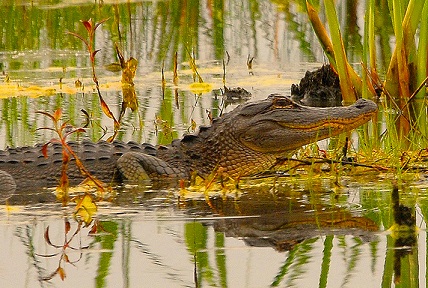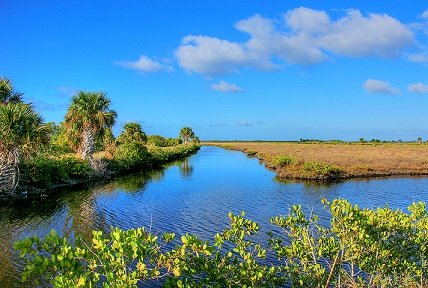The refuge traces its beginnings to the development of the nation's Space Program. In 1962, NASA acquired 140,000 acres of land, water, and marshes adjacent to Cape Canaveral to establish the John F. Kennedy Space Center. NASA built a launch complex and other space-related facilities, but development of most of the area was not necessary. In 1963, the U.S. Fish and Wildlife Service signed an agreement to establish the refuge and in 1975 a second agreement established the Canaveral National Seashore. The best time to view wildlife is early morning or late afternoon, and the refuge is open from sunrise to sunset daily.
Merritt Island National Widlife Refuge was established in 1963 as an overlay of NASA's John F. Kennedy Space Center for the protection of migratory birds. Consisting of 140,000 acres, the Refuge provides a wide variety of habitats: Coastal dunes, saltwater marshes, freshwater impoundments, scrub, pine flatwoods, and hardwood hammocks that provide habitat for more than 1,500 species of plants and animals and 15 federally listed species. You can expect to see the following:
Birds
The refuge's coastal location, tropic-like climate, and wide variety of habitat types contribue to the refuge's diverse bird population. To date, 358 species have been identified on the refuge.
Endangered Species
The refuge manages habitat for over 500 species of wildlife. These habitats support one of the highest numbers of endangered and threatened species found within the National Wildlife Refuge system.
Fish
More than 140 species of freshwater and saltwater fish are known to use refuge impoundments, estuaries, and freshwater wetlands. Fish within the refuge are important to the ecology of the area and recreation.


Habitats
The habitats of the refuge include wetlands (both salt and fresh water), upland shrubland, wetland forest, mesic and upland forest, and beach and dune.
Invasive Species
Exotic, invasive, and nuisance plants and animal species is one of the priority management issues for the Merritt Island NWR. Nuisance animal species have a negative impact on threatened and endangered species.
Mammals
There are many species of mammals on the refuge. Some of the larger ones include bobcats, otters, manatees, and deer.
Reptiles
Adult alligators are apex predators critical to the biodiversity of habitats and wetland ecosystems and can be found in many areas of the refuge.
S.R. 406, Titusville, FL
321- 861-0667